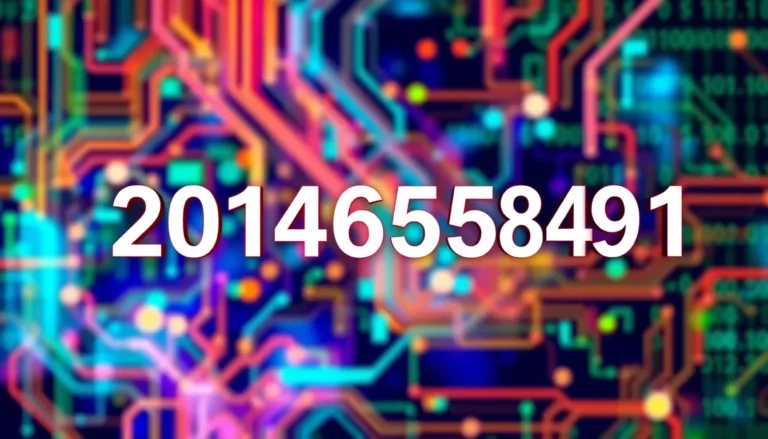The Internet of Things (IoT) is rapidly transforming industries and daily life, connecting devices in ways that were once unimaginable. As businesses and consumers increasingly embrace smart technology, the IoT market is poised for explosive growth. This shift not only enhances efficiency but also opens new avenues for innovation and revenue.
Understanding the dynamics of the IoT market is crucial for stakeholders looking to capitalize on its vast potential. From healthcare to agriculture, the applications are diverse and far-reaching. Analyzing market trends, key players, and emerging technologies can provide valuable insights into the future landscape of IoT, making it an essential topic for anyone interested in the intersection of technology and business.
Table of Contents
ToggleOverview of IoT Market Analysis
The IoT market exhibits rapid growth, driven by advancements in connectivity and data analytics. Global investments in IoT technologies are projected to reach approximately $1.1 trillion by 2026, demonstrating increased interest from both businesses and consumers.
Key Market Dynamics
- Market Drivers: Increased adoption of smart devices in areas such as home automation and industrial applications boosts market growth.
- Market Challenges: Security concerns and data privacy issues remain significant barriers, impacting consumer trust.
- Regulatory Environment: Emerging regulations influence development and deployment, affecting market dynamics.
Sector Applications
- Healthcare: IoT integration in medical devices enhances patient monitoring, resulting in improved health outcomes.
- Agriculture: Smart farming solutions optimize resource use, leading to better crop yields and reduced waste.
- Transportation: Connected vehicles improve safety and efficiency, contributing to the development of smart cities.
Competitive Landscape
A diverse array of players shapes the IoT market, including technology giants, startups, and established corporations. Major companies like Cisco, IBM, and Amazon Web Services invest heavily in IoT solutions, enhancing their market position.
Emerging Technologies
- 5G Networks: Enhanced connectivity supports higher device density and faster data transmission, accelerating IoT deployment.
- Edge Computing: Processing data closer to the source reduces latency, improving real-time data analysis and responsiveness.
Trend Analysis
Recent trends indicate a shift towards increased interoperability and open standards among devices. Collaborative ecosystems foster innovation and drive adoption across various sectors.
Understanding these factors enables stakeholders to navigate the evolving IoT landscape effectively, positioning themselves for future success in this dynamic market.
Key Market Trends

The IoT market is witnessing significant changes as it rapidly evolves. Understanding current trends aids stakeholders in making informed decisions and adapting to market shifts.
Growth Drivers
- Increased Investment: Global investments in IoT are on track to reach approximately $1.1 trillion by 2026, reflecting heightened interest from businesses seeking efficiency through smart technology.
- Enhanced Connectivity: Advancements in 5G networks improve device connectivity, allowing for faster data transmission and more reliable communication between devices.
- Data Analytics Improvement: Innovative data analytics solutions enable organizations to process and analyze vast amounts of real-time data, leading to actionable insights that drive decision-making.
- Adoption of Smart Devices: The rising popularity of smart devices across industries—from healthcare to agriculture—supports seamless integration of IoT technologies into everyday operations.
- Regulatory Support: Governments worldwide are introducing regulations that promote IoT development, ensuring compliance while facilitating market growth.
Challenges Facing the Market
- Security Concerns: The increased number of connected devices raises security vulnerabilities, making data breaches and hacking threats a significant issue for organizations.
- Data Privacy Issues: As the amount of collected data grows, so do concerns regarding user privacy and how organizations handle sensitive information.
- Interoperability Challenges: Disparate systems and protocols hinder seamless communication between devices, complicating integration efforts and limiting functionality.
- High Implementation Costs: The initial investment for IoT infrastructure can be prohibitive, particularly for small and medium-sized enterprises, hindering widespread adoption.
- Skill Shortages: A lack of qualified professionals with expertise in IoT technology restricts growth potential, as companies struggle to find talent to manage complex systems effectively.
Market Segmentation
Market segmentation in the IoT sector delineates distinct areas of opportunity based on application and geography. Understanding these segments enables stakeholders to target their strategies effectively.
By Application
IoT applications span several industries, each exhibiting unique needs and growth potential.
- Healthcare: IoT enhances patient monitoring through wearable devices and remote health management systems. Market growth in healthcare is projected to reach over $100 billion by 2025.
- Agriculture: Smart farming solutions optimize resource usage, improve crop yield, and reduce costs. The agricultural IoT market is set to grow by 14% annually.
- Transportation: Connected vehicles improve safety and efficiency, driving the adoption of IoT in logistics and fleet management. Estimates indicate a market worth $300 billion by 2026.
- Smart Homes: Home automation devices, including security systems and energy management solutions, contribute significantly to the consumer IoT market. The smart home market is expected to surpass $200 billion in revenue by 2025.
By Region
Geographical segmentation reveals varying adoption rates and infrastructure readiness.
- North America: Leading in IoT adoption, North America accounts for approximately 35% of the global market. The presence of tech giants and robust infrastructure fuels this growth.
- Europe: Europe experiences steady IoT expansion, focusing on smart cities and sustainability initiatives. The region shows an annual growth rate of about 18%.
- Asia-Pacific: Rapid industrialization and urbanization drive significant IoT adoption in Asia-Pacific. The market is expected to expand by over 25% through 2026.
- Latin America: Emerging economies in Latin America embrace IoT technologies, albeit at a slower pace due to infrastructure challenges. The market is projected to grow by 15% annually.
- Middle East and Africa: The region witnesses increased investment in IoT, particularly in smart city initiatives and renewable energy projects. Annual growth rates are anticipated at around 10%.
Competitive Landscape
The competitive landscape of the IoT market features diverse players and complex dynamics. Understanding the contributions of key organizations and the distribution of market shares helps stakeholders navigate this evolving terrain.
Major Players
Major companies actively drive the IoT market forward. Key leaders include:
- Cisco: Focused on developing robust networking technologies that support IoT infrastructures.
- IBM: Specializes in AI and cloud solutions for IoT applications, enhancing data processing capabilities.
- Amazon Web Services: Offers scalable cloud solutions that facilitate IoT device management and data analytics.
- Microsoft: Provides IoT platforms that integrate with existing software and services across various industries.
- Siemens: Offers IoT solutions for industrial applications, enhancing operational efficiency through automation.
These companies are heavily investing in IoT technologies, driving innovation and shaping industry standards.
Market Share Analysis
Market share distribution reveals the competitive dynamics within the IoT sector. The following table outlines the estimated market share percentages for key players:
| Company | Estimated Market Share (%) |
|---|---|
| Cisco | 12% |
| IBM | 10% |
| Amazon Web Services | 15% |
| Microsoft | 8% |
| Siemens | 7% |
| Others | 48% |
The “Others” category includes numerous smaller firms and start-ups that contribute to niche markets and emerging technologies. This diverse landscape offers significant opportunities for growth and collaboration while encouraging innovation among established and new entrants alike.
Future Outlook
The IoT market is set for substantial growth, influenced by advancements in technology and increasing consumer demand. The integration of 5G networks enhances device connectivity, enabling faster data transmission and real-time monitoring. By 2026, global IoT investment might reach $1.1 trillion, reflecting escalating interest from both businesses and consumers.
Emerging trends indicate a focus on enhanced interoperability among devices. Companies are collaborating to create open standards, fostering environments where distinct IoT systems communicate seamlessly. This shift promotes innovation across various sectors, resulting in better product offerings and consumer experiences.
Key sectors will continue to evolve with IoT applications. The healthcare sector, for example, may surpass a market value of $100 billion by 2025, emphasizing the significance of remote patient monitoring and telehealth solutions. Agriculture can expect similar momentum through precision farming technologies that optimize resource utilization.
Investments in smart home technologies may see the market exceeding $200 billion, driven by an increasing appetite for home automation, security, and energy efficiency. The transportation sector is also poised for transformation, with connected vehicles enhancing safety and operational efficiency.
Regionally, North America leads in IoT adoption, bolstered by robust infrastructure and investment. Europe and Asia-Pacific follow closely, with each region showcasing different growth narratives shaped by local market conditions and regulatory frameworks. Understanding these differences allows stakeholders to align strategies with the unique attributes of each market.
Challenges remain significant. Companies must prioritize addressing security vulnerabilities and data privacy concerns to foster consumer trust. Moreover, high implementation costs and skill shortages can hinder widespread adoption. By tackling these issues, stakeholders can better position themselves within the evolving IoT landscape, ensuring long-term success as the market continues to expand.
The IoT market stands at a pivotal moment with immense potential for growth across various sectors. As technology advances and consumer demand rises stakeholders must remain vigilant in addressing challenges like security and data privacy. The dynamics of this market continue to evolve with emerging technologies paving the way for innovative applications.
By understanding regional differences and market segmentation companies can tailor their strategies to seize opportunities. The future of IoT is bright with significant advancements on the horizon promising to reshape industries and enhance everyday life. Embracing this transformation will be key for those looking to thrive in the ever-changing landscape of the Internet of Things.



